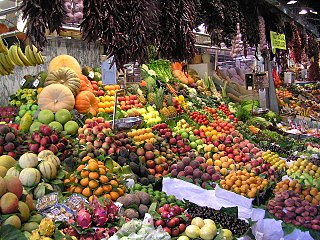
Caribbean cuisine is a fusion of African, Creole, Cajun, Amerindian, European, Latin American, East/North Indian, Middle Eastern, and Chinese. These traditions were brought from many different countries when they came to the Caribbean. In addition, the population has created styles that are unique to the region.

Fufu is a staple food common in many countries in West Africa such as Sierra Leone, Ghana, Liberia, Togo and Nigeria. It is often made in the traditional Ghanaian and Nigerian method by mixing and pounding separate equal portions of cassava and green plantain flour thoroughly with water. It is then adjusted to either increase or decrease the viscosity of the fufu depending on personal preferences. Other flours, such as semolina, maize flour or mashed plantains may take the place of cassava flour. Fufu is often served with groundnut soup, palm nut soup or light soup.

The culture of Dominica is formed by the inhabitants of the Commonwealth of Dominica. Dominica is home to a wide range of people. Although it was historically occupied by several native tribes, the Taíno and Island Caribs (Kalinago) tribes remained by the time European settlers reached the island. "Massacre" is a name of a river dedicated to the murders of the native villagers by French and British settlers, because the river ran red with blood for days. Each claimed the island and imported slaves from Africa. The remaining Caribs now live on a 3,700-acre (15 km2) Carib Territory on the east coast of the island. They elect their own chief.

Callaloo is a popular Caribbean dish originating in West Africa served in different variants across the Caribbean. The main ingredient is a leaf vegetable, traditionally either amaranth, taro or Xanthosoma. Because the leaf vegetable used in some regions may be locally called "callaloo" or "callaloo bush" "Dasheen Leaves", some confusion can arise among the vegetables and with the dish itself. In Haiti, for example, the creole word "kalalou" refers to okra, and not to a leafy green. Outside of the Caribbean, water spinach is occasionally used. Trinidadians, Grenadians and Dominicans primarily use taro/dasheen bush for callaloo, although Dominicans also use water spinach. Jamaicans, Belizeans and Guyanese on the other hand use the name callaloo to refer to amaranth, and use it in a plethora of dishes and also a drink. The 'callaloo' made in Jamaica is different from the 'callaloo' made in Trinidad and Tobago Grenada and rest of the Caribbean in terms of main ingredient and other ingredients included. "callaloo" in Trinidad is used in a variety of dishes including Callaloo soup "callaloo bhaji" two Trinidads specialities. Callaloo is the National Dish of the twin Island Republic of Trinidad and the Commonwealth of Dominica.
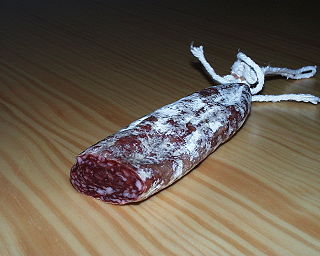
Longaniza is a Spanish sausage (embutido) similar to a chorizo and also closely associated with the Portuguese linguiça. Its defining characteristics are interpreted differently from region to region. It is popular in the cuisines of several regions of Spain, Puerto Rico, Dominican Republic, El Salvador, Mexico, Chile, Argentina, and Uruguay. In the Philippines, it is called longganisa and differs greatly with hundreds of variants with different vernacular tastes and forms due to the 144 ethno-linguistic groups in the archipelago.

Spondias dulcis, known commonly as ambarella (ඇඹරැල්ලා) in Sri Lanka or June plum is an equatorial or tropical tree, with edible fruit containing a fibrous pit. It is known by many other names in various regions, including kedondong in Indonesia and in Malaysia, umbra in Malaysia, buah long long among the Chinese population in Singapore, Isbaandheys' in Somalia, Embe Ng'ong'o' in Tanzania, prune de cythère, pommecythere, or golden apple in Trinidad and Tobago, Dominica, Guadeloupe, Suriname, Saint Lucia and Martinique, June plum in Bermuda and Jamaica, mangotín in Panama, yuplón in Costa Rica, golden apple in Grenada, Saint Vincent and the Grenadines, Barbados and Guyana, golden plum in Belize, jobo indio in Venezuela, cajá-manga and cajarana in Brazil and São Tomé and Príncipe, quả cóc in Vietnam, /məkaʔ/ (ម្កាក់) in Cambodia, amra in Bangladesh, manzana de oro in Dominican Republic, cas mango in Cameroon, Maldives, vi in Samoa, Tonga, and Hawaii. In Seychelles frisiter and มะกอกบก หรือ มะกอกฝรั่ง in Thailand.

The following outline is provided as an overview of and topical guide to Dominica:

Azua Dominica Airport is an airport 2 kilometres (1.2 mi) south of the city of Azua in the Azua Province of the Dominican Republic. It is an old airport that is used only for the emergency landing of domestic flights. This airport has never had regularly scheduled flights, although some airlines have operated charter or tourist flights here.
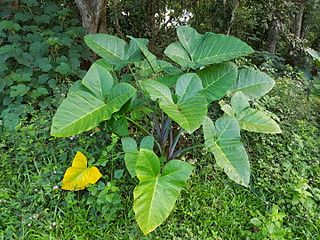
Xanthosoma sagittifolium, the arrowleaf elephant ear or arrowleaf elephant's ear, is a species of tropical flowering plant in the genus Xanthosoma, which produces an edible, starchy corm. Cultivars with purple stems or leaves are also variously called blue taro, purple taro, purplestem tannia, and purple elephant's ear among others.
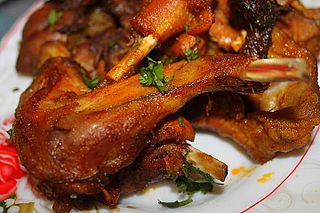
The cuisine of Algeria is influenced by Algeria's interactions and exchanges with other cultures and nations over the centuries. Algerian cuisine is typically a mix of Berber, Arabic, Andalusian, and Mediterranean cuisines with slight European.

Tostones are twice-fried plantain slices. Most commonly known as tostones, they are also known as tachinos or chatinos (Cuba), Platano frito, bananes pesées (Haiti), patacón pisao in Colombia and patacones.

The cuisine of the Americas is made up of a variety of food preparation styles.

Chadian cuisine is the cooking traditions, practices, foods and dishes associated with the Republic of Chad. Chadians use a medium variety of grains, vegetables, fruits and meats. Commonly consumed grains include millet, sorghum, and rice as staple foods. Commonly eaten vegetables include okra and cassava. A variety of fruits are also eaten. Meats include mutton, chicken, pork, goat, fish, lamb and beef. The day's main meal is typically consumed in the evening on a large communal plate, with men and women usually eating in separate areas. This meal is typically served on the ground upon a mat, with people sitting and eating around it.
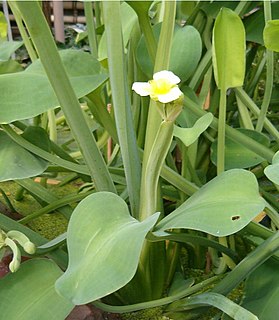
Limnocharis flava is a species of aquatic flowering plant which is native to Mexico, Central America, South America, Cuba, Haiti and the Dominican Republic but widely naturalized in southern and southeastern Asia: India, Sri Lanka, Cambodia, Burma, Thailand, Vietnam, Indonesia, Malaysia and southern China.

Brown stew chicken, also referred to as stew chicken, is a dish typically eaten for dinner throughout the English speaking Caribbean islands. The dish is popular in Jamaica, Antigua, Trinidad and Tobago, Barbados, Saint Lucia, Grenada, Belize, Dominica and in Caribbean communities throughout the world. The dish is called brown because of the distinct dark colour of the dish. The colour is achieved by browning the chicken in brown sugar, which creates a rich gravy to which main vegetable components like onions, garlic and carrots are added.
